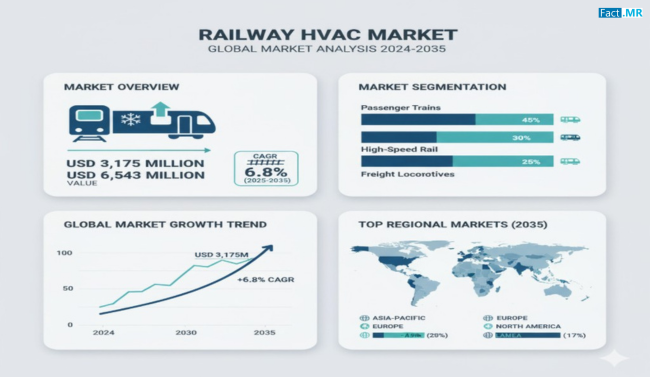The railway HVAC market is witnessing significant growth as rail operators worldwide focus on enhancing passenger comfort, energy efficiency, and operational performance. Heating, ventilation, and air conditioning (HVAC) systems are integral to modern trains, ensuring a comfortable cabin environment while optimizing energy use and adhering to regulatory standards.
With the expansion of urban rail networks, high-speed rail systems, and long-distance passenger trains, demand for advanced HVAC technologies is rising. Rail operators are increasingly adopting innovative HVAC solutions to meet passenger expectations, improve system reliability, and reduce maintenance costs. The market reflects the broader modernization trends in the railway sector, emphasizing sustainability, safety, and passenger satisfaction.
Market Overview
Railway HVAC systems encompass a range of technologies designed to regulate temperature, humidity, and air quality inside train coaches. Modern systems are engineered to provide consistent airflow, filtration, and thermal control, ensuring passenger comfort across diverse climates and operational conditions.
The market is driven by the adoption of energy-efficient HVAC systems, which reduce power consumption and environmental impact. Integration with smart control systems allows operators to monitor performance, detect faults, and optimize energy use in real time. Additionally, modular and lightweight designs are enhancing system adaptability for various train types, including high-speed, metro, and commuter rail systems.
Regulatory mandates and environmental standards are encouraging rail operators to replace traditional HVAC units with eco-friendly, low-emission alternatives. Manufacturers are focusing on low-noise operation, compact designs, and advanced refrigerants that comply with global sustainability guidelines.
With increasing passenger expectations and the growth of urban and intercity rail transport, railway HVAC solutions are becoming a critical differentiator in the competitive railway market.
Regional Insights
Europe is a leading market for railway HVAC systems, driven by the presence of extensive high-speed rail networks and stringent passenger comfort regulations. European operators are integrating advanced HVAC technologies that optimize energy efficiency and provide reliable thermal management across varying climates.
Asia-Pacific is emerging as a major growth region, supported by rapid railway expansion and government investments in metro and high-speed rail infrastructure. Countries such as China, India, and Japan are focusing on energy-efficient and high-capacity HVAC systems to support growing urban transit networks and long-distance rail operations.
North America is witnessing steady adoption of railway HVAC solutions in commuter and intercity rail services. Focus on passenger experience, sustainability, and retrofitting older train fleets with modern HVAC units is driving regional market growth.
In Latin America and the Middle East & Africa, increasing investments in urban rail projects and modernization of existing networks are creating opportunities for advanced HVAC solutions. Rail operators in these regions are prioritizing reliable, low-maintenance systems to improve operational efficiency and passenger satisfaction.
Key Trends & Forecast
- Energy-Efficient HVAC Systems:
The adoption of energy-efficient and eco-friendly HVAC technologies is growing rapidly. Systems are being designed to optimize power consumption without compromising passenger comfort, aligning with global sustainability goals. - Smart and Connected Solutions:
Integration of IoT and digital monitoring enables predictive maintenance, real-time system performance tracking, and automation of climate control based on passenger load and external conditions. - Modular and Lightweight Designs:
Modern HVAC units are increasingly modular, allowing easy installation, maintenance, and adaptability to various train models. Lightweight materials improve energy efficiency while reducing overall operational costs. - Enhanced Air Quality and Filtration:
With rising passenger awareness regarding hygiene and indoor air quality, HVAC systems are incorporating advanced filtration technologies to remove dust, allergens, and pathogens, ensuring a healthier travel environment. - Retrofitting and Upgrading Existing Fleets:
Rail operators are upgrading older trains with modern HVAC systems to improve energy efficiency, reduce maintenance requirements, and enhance passenger experience without replacing entire fleets. - Focus on Thermal Comfort and Noise Reduction:
Modern designs are reducing operational noise while maintaining optimal thermal control. Improved insulation, silent compressors, and smart airflow management are contributing to enhanced passenger comfort.
These trends indicate a market shift toward intelligent, sustainable, and passenger-centric railway HVAC systems designed for modern transportation demands.
Applications & End-Use Outlook
Railway HVAC systems are essential across multiple rail transport segments, including high-speed trains, metro systems, commuter trains, and long-distance passenger services.
In high-speed rail, HVAC systems are designed to withstand high velocity and pressure differentials while maintaining consistent cabin climate. Advanced control systems ensure passenger comfort over long journeys and varying environmental conditions.
Metro and urban rail systems require compact, energy-efficient HVAC solutions capable of frequent start-stop operations and high passenger density. These systems are engineered for durability, low noise, and easy maintenance to support continuous urban transit operations.
For commuter and intercity trains, HVAC solutions focus on energy efficiency and flexibility, accommodating varying occupancy levels and seasonal temperature variations. Smart climate control enhances passenger satisfaction and reduces operational costs.
Additionally, freight and specialized rail applications are adopting climate-controlled HVAC systems to preserve cargo integrity, particularly for sensitive goods such as pharmaceuticals and perishable food items.
The increasing focus on passenger safety, air quality, and comfort is driving railway operators to invest in advanced HVAC systems that deliver consistent performance while meeting environmental and regulatory standards.
Conclusion
The railway HVAC market is evolving rapidly to meet the growing demands of modern rail transport. With increasing passenger expectations, stringent environmental regulations, and a focus on operational efficiency, advanced HVAC systems have become a key component of rail infrastructure.
Manufacturers are leveraging innovations in energy efficiency, smart automation, and air quality management to deliver systems that enhance passenger comfort, reduce costs, and support sustainable operations. The integration of modular and retrofit-ready solutions ensures that both new and existing fleets can benefit from cutting-edge HVAC technology.
As rail networks expand and modernize globally, railway HVAC systems will play an increasingly critical role in ensuring safe, comfortable, and environmentally responsible travel. Access to comprehensive market insights allows operators and manufacturers to adopt future-ready solutions, optimize performance, and create a superior travel experience for passengers worldwide.
Browse Full Report – https://www.factmr.com/report/4198/railway-hvac-market



